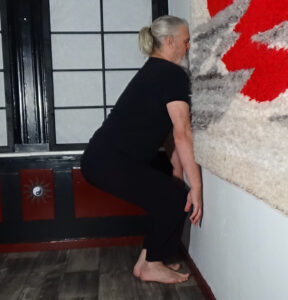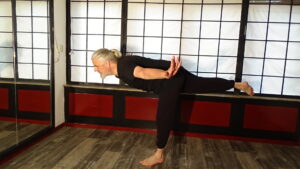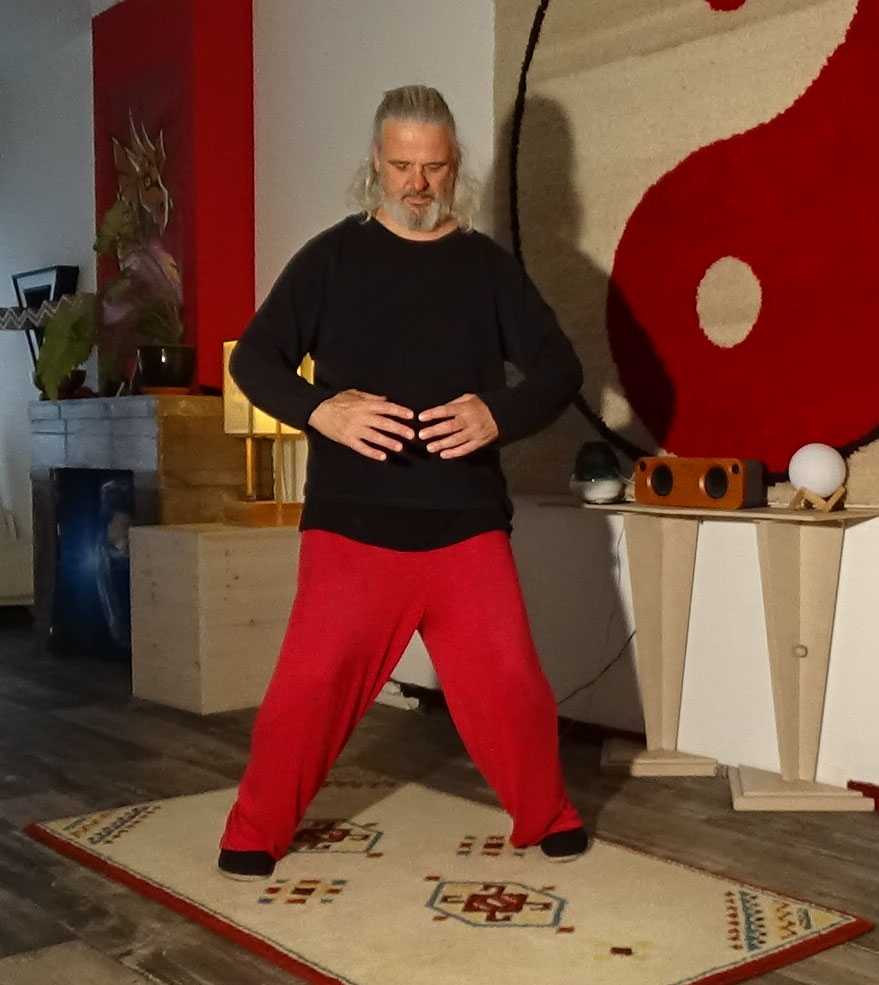The added value of a gong
Performing a gong means that you practice the same Qigong exercise every day for 100 days in a row. If you miss a day, you have to start over again. Therefore it’s important to cultivate your self-discipline. If you don’t miss a single day, your daily practice gets incorporated into your life’s rhythm.
The word Qigong consists of qi = energy and gong means ‘practice’. In practice you spend a lot of time and attention on developing a skill. But also developing and cherishing that good habit, and cultivating a good posture.
 You cultivate the ability to switch in your mind and body. A switch that can convert you from activity and effort to relaxation and rest at any time you choose..
You cultivate the ability to switch in your mind and body. A switch that can convert you from activity and effort to relaxation and rest at any time you choose..
To avoid disappointment, you should not expect to achieve all of this in those first 100 days. But the impetus for it is there, it is something that sticks with you.
The Canadian doctor and writer Gabor Maté calls an addiction “a habit that temporarily relieves your suffering.” In that light you could also see practicing Qigong, but then without the harmful side effects that an addiction to substances or harmful habits causes. (alcohol, drugs, gambling, food, sex, buying and you name it).
Under the influence of Qigong exercises your body does not deteriorate; on the contrary. And your mind does not become dull; also on the contrary.
When I discovered Qigong I started practicing more often after about 10 lessons with the help of an audio CD. After that my frequency of practicing quickly increased from 2x per week to almost daily. In total I practiced Qigong for 3 months before I started my first gong; and that is on average quite fast. It can (and may!) take a year, while others may start a gong after just one Qigong class.
You are not obliged to do anything; but let the need to practice grow. Slowly or quickly is up to you, but work towards it.
The ‘Lift Qi up, pour Qi down’ is the most suitable exercise for your first gong. This exercise ensures makes you collect a lot of Qi; and that’s a good basis for further development.
Of course, it is easier to start with a gong after you have mastered the movements in the basic exercise of Lift Qi Up, Pour Qi Down (LCU) a little and have learned to understand the structure of the exercise.
Self-discipline is very important because you soon discover that there is a strong and cunning opponent hidden within you; ‘your monkee-mind’, that annoying voice in your head, is able to come up with thousands of very valid sounding reasons NOT to practice.

Most heard excuse: I don’t have time!
But if you add up all the lost moments that pass by in one day and you consider, for example, that the average person views adds 20 minutes every day, you may see time differently. You could have practiced Qigong in that time. You don’t have to make time, just find it.
Second excuse:
it is always too busy at home with partner, kids and various social obligations. Meanwhile you are sitting in front of the TV and the rest of the family has already withdrawn. You could have practiced Qigong now. That also applies to the morning hours when partner and kids are still asleep. Practicing may take a bit of effort!
Third excuse:
What am I doing all this practicing for; a period of a few weeks in which you made very fast progress can (and will) suddenly end and now a period in which you are completely at a standstill and nothing is happening occurs. As if the transformation, which was so clearly noticeable at first, has completely disappeared. You start to doubt the usefulness of your exercise. But don’t worry; this is normal and happenes to almost everybody in Qigong practice. You are being tested because you are struggling to reach a higher level. Your mind has got the taste and wants to transform further, but your body is still holding back the change, afraid to let go. Or exactly the other way around: your body wants to continue, but your mind is not yet able to take the next step. It is as if you are facing a height and you cannot yet imagine that you will ever be able to climb it.
Keep going; there will come a day when suddenly you feel that you have climbed that hill. And the great thing is you can easily maintain that level. Once you have climbed, you will not descend that easily. Haula!
Performing a gong ensures that you will break through all possible excuses. ‘Be stronger than your excuse!’

Your mind is under the control of a pattern in your subconcience called Homeostasis. Your body and mind seek balance all the time. Practicing Qigong gets it off balance – in a good way, but still …- Yor leaving a safe domain and homeostasis ensures your mind nor your body likes to change. A transformation is taking place and your mind cannot predict where that will all lead. And it does not like that at all; your mind is attached to safety. In Qigong we say: ‘we leave the domain of safety behind for the kingdom of freedom’.
Indeed, you will occasionally go through deep lows when you turn your gaze inward and (re)discover your traumas, fears, sadness, anger and so on. All the things you were hiding away. Your mind is conditioned to do so; that is that (apparent) safety. Because all the hidden pain, trauma and emotions will come back up at some point. And because this rediscovering of trauma happens when you are relaxed, the hidden pains makes it hard to really relax again. You have to let go or your Qi, your life force, will contract and stagnate. A tension and distortion that can lead to the most serious ailments.
A gong is a means to learn to break the habit of hiding your pain. Nothing that you (re)discover yourself, your real you, is new to you. Deep down you know what you have hidden away. The great thing is that once you learn to really surrender, to really accept everything that is inside you, it is not at all difficult to accept it and then let it go; you were conditioned by fear.
Tips:
Start with a gong as soon as you notice that you have collected enough Qi. Give yourself time to increase your reservoir of Qi in your lower Dantian (lower abdomen). When you are just starting out, you will draw enough Qi with one weekly session to last a couple of days. During each new session you will absorb more Qi and eventually you will automatically feel that you can use more than what you collect in Qi with one class per week. At that point you can start with a gong.
See for yourself whether you like to practice at a fixed time every day or not. Personally, I find working by the clock a horror, but I did discover that I like to do my gongs before 12 noon. That is because you get the most benefit from it all day long. But the Lift Qi Up can also ensure that you relax before going to sleep and that you enjoy a much better night’s sleep. Find your own way!
The daily repetition of your exercise makes you aware that performing the movements only has an effect if you put your whole heart into the exercise. Perhaps you will notice one day that you move mechanically while your head is somewhere else and not with your exercise. As soon as you notice this, you can get annoyed that you are wasting your time in this way. And that is fine because now it is a challenge to perform your exercise completely consciously again.
It can happen that a recent event or a situation pulls you so off balance so bad it seems almost impossible to let go. See this as a challenge too; as a sign that you have to take action, resolve or neutralize the situation so that you can consciously switch the button to relaxation again during your exercise.
 The best exercise to do your first gong with is the Lift Qi Up, Pour Qi Down exercise. The Lift Qi Up accumulates the most Qi; a wonderful basis for possible subsequent gongs.
The best exercise to do your first gong with is the Lift Qi Up, Pour Qi Down exercise. The Lift Qi Up accumulates the most Qi; a wonderful basis for possible subsequent gongs.
Once you have acquired the taste of completing gongs, you can choose another light exercise such as the Sway La Qi as a gong.
The 3 centres merge is a bit harder to do. Start with 10 minutes and try to slowly increase that to at least half an hour during the gong – for example, do the exercise for 10 minutes the first 20 days, day 20 to 40 15 minutes etc.
The wall squats and Cranes Walk are physically quite a challenge, but super good to do in a gong.
Heavier exercises such as Chen Chi and Chen Bi (both you have to keep up for at least 15 minutes a day) are a big step further. I myself only started doing these exercises in a gong after 5 years of training and doing gongs. But if you want to reach a high level, these exercises are really recommended.
Supergong:
A normal gong lasts 100 days. A supergong is the exercise to perform for 1000 hours. There is an exercise that is really suitable for doing a supergong and that is the 3 centres merge – Zhan Zhuang- . The 3 centres merge is an exercise that you as an instructor should actually learn to do every day and a supergong helps you to establish this habit deep in the core of your body and mind. Zhan Zhuang is only really effective if you do it for at least 30 minutes a day. A supergong lasts at least 2000 days in this way, but it is not inconceivable that after a while you will do it for an hour a day. (Li Hongshi has been doing this for decades, for example).
Tip: if you use Facebook: become a member of the FB group ‘1000 hours of standing Zhan Zhuan
Don’t be put off by these numbers: performing a Lift Qi Up pour Qi Down for 100 days gives a remarkably good result; we don’t all have to become teachers and healers. With the Lift Qi Up you learn to heal yourself and that is quite something.
